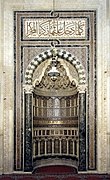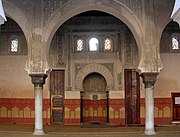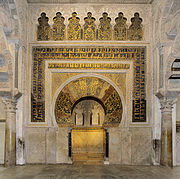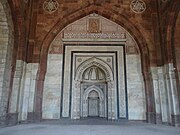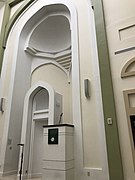Mihrab
This article needs additional citations for verification. (October 2011) |
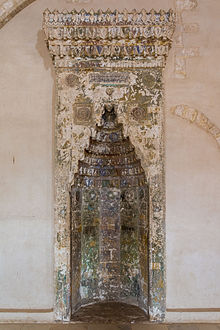
| Part of a series on |
| Islamic culture |
|---|
| Architecture |
| Art |
| Clothing |
| Holidays |
| Literature |
| Music |
| Theatre |
Mihrab (Arabic: محراب miḥrāb, pl. محاريب maḥārīb) is a semicircular niche in the wall of a mosque that indicates the qibla; that is, the direction of the Kaaba in Mecca and hence the direction that Muslims should face when praying. The wall in which a mihrab appears is thus the "qibla wall".
Mihrab should not be confused with the minbar, which is the raised platform from which an Imam (leader of prayer) addresses the congregation. The mihrab is located to the left of the minbar.
Etymology
The word is possibly derived from the verb ḥariba ("to fight", from the root Ḥ-R-B), so miḥrāb would mean "battlefield" or "place of fight (with Satan)". Some scholars have suggested that the word is from the Ethiopian mekʷerab, or from the Hebrew ḥorḇôt.[1]
History
The origin of the word miḥrāb can be traced back to Iranian mythology and relates to the worship of the god Mehr (Mithra, Mitra, Meitros, Mihr or Meher). Mehr was the god of an ancient pre-Zoroastrian Iranian religion started sometime before 1000 BC. Later Greeks and Romans also adopted Mehr (Mithra) as their own god with subsequent spread of the religion through vast regions of Europe. Mehr was the god of justice and sun light, the source of illumination that lit everything. Therefore, Mehr was invoked in oaths and whenever people needed clarity and honesty.
One delicate point about miḥrāb is the word āb. Āb means water in the modern Persian language, but in ancient Iran the words āb (aab), ābeh (aabeh) or āveh (aaveh) were used to define a barrel vault ceiling. In Mehr (Mihr) religion temples, this specific structural design element symbolized the dome of heavens, or the cosmos, and was considered the most holy place in the religion. It was a window opening to the God Mehr and, therefore, was called meḥrāb. Miḥrāb is the Arabized Persian meḥrāb or meḥrābeh which has continued in the post Islamic period as the name for the arched niche which points to the holiest place in the Islamic tradition in a mosque. Mehr’s position later became less than the Zoroastrian’s Ahura Mazda, and the god lost influence and acceptability in Iran. However, Mehr’s birth, on the Winter Solstice, when in the Northern hemisphere the day light begins to lengthen and re-gain power, is still celebrated in the Middle East as The Night of Birth (Yalda Night) and on December 25th as Christ's Birth.
Present-day use
Today, Mihrabs vary in size, are usually ornately decorated and often designed to give the impression of an arched doorway or a passage to Mecca.
In exceptional cases, the mihrab does not follow the qibla direction. One example is the Mezquita of Córdoba, Spain that points south instead of southeast. Among the proposed explanations, there is the localization of the ancient Roman cardo street besides the old temple the Mezquita was built upon.
Another is the Masjid al-Qiblatayn, or the Mosque of the Two Qiblas. This is where the Prophet Muhammad received the command to change the direction of prayer (qibla) from Jerusalem to Mecca, thus has two prayer niches. In the 21st Century the mosque was renovated, and the old prayer niche facing Jerusalem was removed, and the one facing Mecca was left.
Gallery
-
Mihrab in the Mosque of Uqba also known as the Great Mosque of Kairouan; this mihrab dates in its present state from the 9th century, Kairouan, Tunisia
-
Mihrab in the Dome of the Chain, Temple Mount, Jerusalem.
-
Mihrab in the Qila-i-Kuhna Mosque, in Delhi
-
Mihrab in the Islamic Society of Boston Cultural Center, in Roxbury, Boston.
See also
References
- ^ Fehérvári 1993, p. 7
- Diez, Ernst (1936), "Mihrāb", Encyclopaedia of Islam, vol. 3, Leiden: Brill, pp. 559–565.
- Fehérvári, Geza (1993), "Mihrāb", Encyclopaedia of Islam, New edition, vol. 7, Leiden: Brill, pp. 7–15.
1-The Ostia Mithraea: An Introduction to the Cult of Mithras.
brewminate.com/the-ostia-mithraea-an-introduction-to-the-cult-of-mithras-and-tour-o...
2- Cumont, F. The Mysteries of Mithra. Trans. T. J. McCormack. London, 1903, reprint
New York, 1956
3- Renan, E. Marc-Aurèle et la. fin du monde antique. Paris, 1882.
4- JDStone. Mithras= Christianity. - jdstone.org/cr/files/mithraschristianity.html
5- Hugh Fogelman. Christianity uncovers: Viewed through open eyes. page 33
6- Celebrating Yalda Night - Iran Review. www.iranreview.org › Iran Review › About Iran › Iran's Heritage


